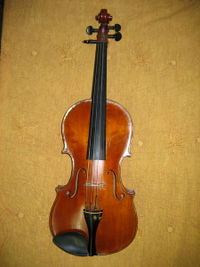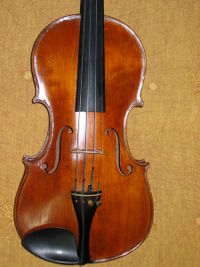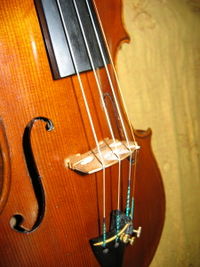NOTE: all violin sound samples were executed by Clara Fanticini on 26 October 2007. Sound Engineer: Valerio Carboni.
Structure of the instrument
The violin is an instrument of great complexity from an acoustic point of view. As with almost all instruments, the experience of their builders and players has empirically perfected their characteristics over the course of time.
The acoustic chain of the violin is composed of the following elements:
- belly, back, ribs: these are the wooden three parts that make up the hollow body of the instrument. There are two f-shaped openings cut into the belly. Both the belly and the back are slightly rounded and thin out from the centre to the edge.
- sound post, bass bar: these are two internal elements of the body of the instrument. The sound post is a small wood cylinder similar to a column between the belly and the back, while the bass bar is a curved strip glued longitudinally under the belly. These two elements have the structural function of distributing loads that are primarily due the tension of the strings and the acoustic function of coupling the oscillations of the belly and back.
- nut, tailpiece, bridge, strings: the first two elements are fixed points between which the strings are held taut. The nut is located at the end of the neck, on the fingerboard, while the tailpiece is near the musician's chin. The bridge determines the effective acoustic length of the strings and transmits their vibrations to the sound board.
How sound is produced
- Sound normally comes from drawing (horse) hairs stretched on a wood bow across the strings. However, since vibrating strings couple very inefficiently with the air (the sound of a string without amplification from the body is very weak), the body of the instrument has a critical function in determining timbre.
- The vibration produced on the strings (discussed in more detail in the following paragraph) is partially transmitted to the bridge and from there to the sound board. The belly is then mechanically coupled to the back by the ribs and a sound post and the vibrations of the entire body of the instrument are coupled with the air both within and surrounding the violin, thanks to the fact that these approximately bidimensional parts of the instrument have a rather large acoustic impedance with respect to the air.
- Therefore, the entire body of the instrument functions as both a resonance body and an impedance adaptor.
- As a resonance body, it "filters" the oscillation of the strings, approximately triangular in origin, through its eigenfrequencies and changes their shape into a more complex form.
- As an impedance adaptor, the body of the violin efficiently transforms the mechanical energy present in the oscillation of the strings into acoustic energy that propagates in the air and, therefore, allows for the transmission of sound at great distances.
The source of oscillations
- The violinist is free to move the bow across the strings in many different ways and it is for this reason that the sound of the violin can assume many different nuances, which both the composer and the player can use to express themselves (see the paragraph psychoacoustic and musical characteristics).
- In fact, the pressure of the bow, the contact area, the speed and direction of sliding, the angle of the hairs to the strings and the dynamics of the bowing (i.e. of the act of "drawing the bow") all greatly influence the timbre of the sound produced. Below, we will examine some of the effects that can be produced through several examples.
- From a physical point of view, the simplest case is when the bow moves with a constant velocity and is pressed perpendicularly to the strings. It is interesting to understand how a "sawtooth" oscillation can be produced on the string under these conditions.
| Bow: tip |
Bow: frog |
Vibration of a drawn string |

|
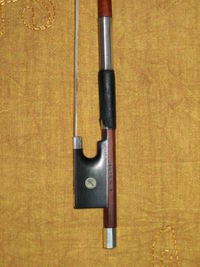
|
|
- When the bow begins to move against a string, the friction between the hairs and the string drags the string along with the bow creating an approximately triangular shape.
- However, once the deformation has become large enough, the elastic force of the string overtakes friction and the string is pulled back towards its position of equilibrium. Since the dynamic friction (between two mutually moving surfaces) is less than the static friction (between two surfaces mutually at rest), the movement of the string continues until the it does not oscillate again in the same direction in which the bow is being drawn.
- From this point onwards, the process repeats cyclically.
- A travelling wave produced this way moves back and forth on the string reflecting at the ends, which can be considered fixed points. This process is better described on the pages Reflection on strings and Interference between reflected waves.
Bowed strings do not move by harmonic motion; i.e. they do not oscillate in just one of their normal modes but in a combination of all normal modes compatible with the conditions of bowing. This means that the strings do not produce just one "pure" sound but a blend of many simultaneous sounds at integer multiple frequencies of a fundamental frequency. The human auditory system interprets this complex signal as a "note" with a pitch equal to that of the pure sound of the fundamental frequency (see pitch) and with a definite timbre.
The fundamental frequency of the free vibration of a string depends on the length, density and tension of the string itself (see Eigenfrequencies of strings) and corresponds to the frequency of the first normal mode of the string. The free strings of the violin produce the notes G3, D4, A4, E5 respectively at about 196, 294, 440, 660 Hz, even if they all are the same length. This means that they are characterised by different densities and tensions.
The formation of timbre
We have seen in the previous paragraph that the oscillation of a string is not sinusoidal in origin but "sawtooth". This means that it already contains many overtones (in principle, an infinite number), each with an amplitude according to the Fourier expansion of the oscillation.
This fact is very important because it allows us to understand that the timbre of an instrument receives a base shaping from the oscillation of the strings but that this can be drastically modified by the filtering action of the body.
In fact, the body, when excited by the complex vibration of the strings, responds according to its normal modes for resonance. This means that it tends to amplify the vibrations at frequencies near one of the resonance frequencies of the system and damps the overtones out of resonance. Therefore, the harmonic components of the original sawtooth wave are each complexly modified in a different measure, which generally depend on the particular fundamental frequency excited (i.e. by the note that the musician is playing).
Acoustic characteristics
Let us illustrate some of the primary acoustic characteristics of the violin through examples.
In the following sonograms, time runs along the vertical axis from top to bottom. The frequency axis is horizontal with higher frequencies towards the right. The spectrum presented in the bottom part of the sonograms refers to the moment in time corresponding to the thin line in the top part of the sonograms and is in a logarithmic scale. The lighter colour corresponds to greater intensity. For an animated guide on how to read sonograms, see the page How is a spectrogram read?
A short piece from J. S. Bach's First Partita for Solo Violin was recorded in an environment with almost no reverb and with the microphone very close to the instrument. The sample corresponds faithfully to what we perceive at a short distance from the instrument but does not reproduce the listening conditions in a concert hall. The sound is very faithful to the original but also very "dry". Both the right and left channels are identical copies of the same signal.

| Wave form |
Spectrogram |
Audio |
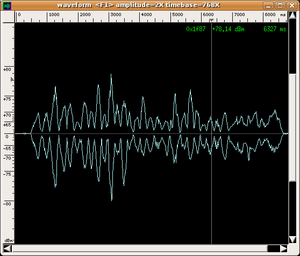
|
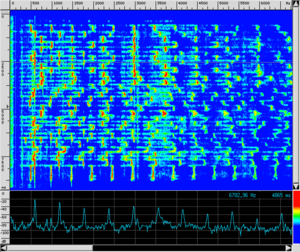
|
|
| Video |
A simple electronic manipulation of the sample is done by introducing a dynamic compression of the sound; i.e. by filtering its spectrum depending on time and on the characteristics of the signal, in order to balance its dynamic. Observe that the right and left channels now show small differences. The net effect is the introduction of a "virtual listening environment", which simulates a slightly reverberant real environment that, therefore, more faithfully reproduces the sound that would be heard in a concert hall. The sound seems much richer overall, even if the pitches and the note lengths are unchanged with respect to the "dry" sample.
| Wave form |
Spectrogram |
Audio |

|

|
|
Natural and artificial harmonics
Harmonic sounds are obtained by lightly touching a string with a finger of the left hand in nodal positions corresponding to various normal modes of the string itself (1/2, 1/3, 1/4, etc. of its length) while the bow makes it vibrate. A node is forced at the point in which the string is touched, however the rest of the entire string (except the ends) remains free to oscillate. The sound produced is not the same as that which would be obtained by stopping the string at the same point but is "softer" because all the vibration modes that do not have a node at the point of touching are suppressed.
| Wave form |
Spectrogram |
Audio |

|
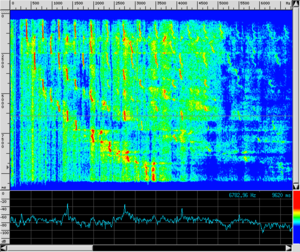
|
|
Sliding a finger along a string in the position of contact, we can distinctly hear a sound of definite pitch when the position of the finger is compatible with a natural harmonic of the string and we hear a similar disharmonic rustling sound when this does not occur. As the note becomes higher, we hear that the "pure" sounds become more frequent. This is not because the finger is sliding faster but because the positions of the first useful nodes are closer. The first node of the nth mode is found at  , where L is the length of the string.
, where L is the length of the string.
| Wave form |
Spectrogram |
Audio |
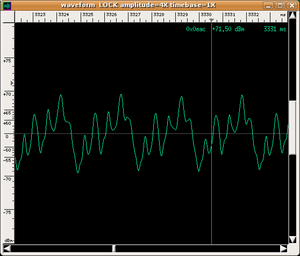
|
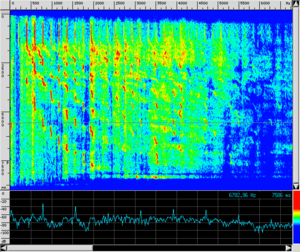
|
|
Harmonic sounds can be produced on the violin not only on open strings. The effect of fingers on the fingerboard is to effectively shorten the vibrating length. If the index finger is used to set a certain length (i.e. playing a certain note), the little finger of the same hand can reach a position that corresponds to a harmonic sound two octaves above the same note. While, its sound quality will still be soft, the pitch can be regulated by moving the hand and obtaining other notes. An analysis of the sonogram makes evident that when the violinist passes from a "full" note to the harmonic, every one in four harmonics are selected; this is equal to quadrupling the frequency of the fundamental.
| Wave form |
Spectrogram |
Audio |
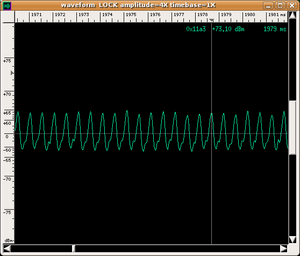
|
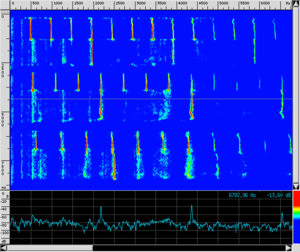
|
|
Bowing techniques
Spiccato is a bowing technique that exploits the natural elasticity of the bow and its hairs to obtain very short sounds in rapid succession. In the sample, four notes are firstly executed with standard bowing (détache) and then eight notes are played with spiccato at two different velocities. The musician regulates the position and angle of contact with the strings and the force applied to best exploit the natural resonance of the bow's wood and hairs. The bow can keep bouncing for a long time with very little energy consumption. Between one contact with the string and another, the bow is actually "in flight" and, therefore, the string oscillates freely. This is evident in the time plot of the wave, in which we can clearly observe that the damping of the first four notes is linear, while that of the slow spiccato is exponential. When the spiccato increases in speed, the damping of each note is interrupted by the attack of the following one.
| Wave form |
Spectrogram |
Audio |
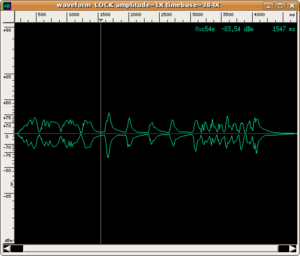
|
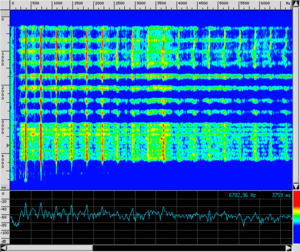
|
|
If, instead of using hairs, we were to strike the strings directly with the wood of the bow, the resulting sound would be much weaker. This is a sign that the coupling between the strings and the surrounding air is small when the excitation is percussive. Listening carefully, we can actually hear two sounds, corresponding to the two lengths of string (to the left and right of the point of impact). The second sound is much higher than the first and is no longer perceptible at a small distance from the instrument.
| Wave form |
Spectrogram |
Audio |
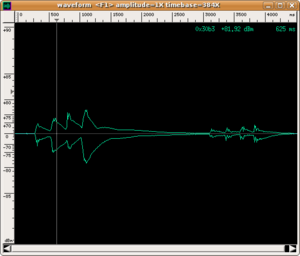
|
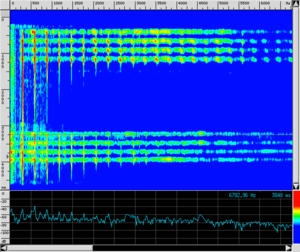
|
|
In this sample, the string is drawn with the wood of the bow instead of the hairs. The sample highlights the importance of the friction between the hairs and the string and explains why players of bowed instruments coat their strings with colophony, a resin that increases friction. Drawing by wood takes place with much less friction and transmits a very small force to the string creating a noisy sound with weak intensity.
| Wave form |
Spectrogram |
Audio |
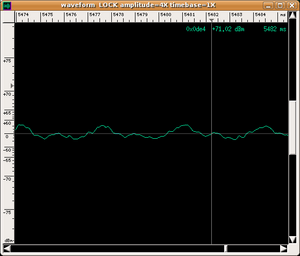
|
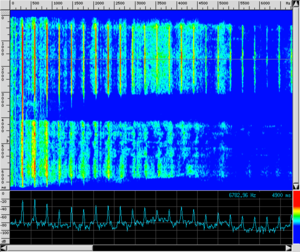
|
|
"Pizzicato" is not obtained by bowing but rather by the player plucking the string with their fingers. Its sound is surprising weak with respect to a bow stroke. It is easy to see that the construction characteristics of the violin are not ideal for making it a plucked string instrument. However, composers often use pizzicato as an effect.
| Wave form |
Spectrogram |
Audio |
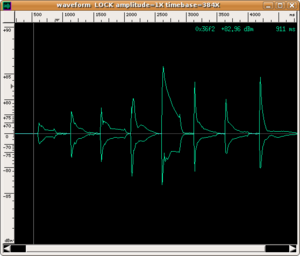
|
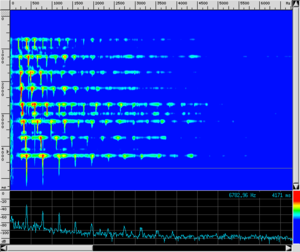
|
|
The role of the strings
Obviously, the strings are the source of all vibrations; but how does sound change when using strings of different materials? Material determines the density and elasticity of the string, therefore, using different materials can allow for the playing of the instrument in different excitation regimes. In particular, the traditional use of natural strings can sometimes make the violin sound a bit nasal, however, they often produce a sweeter sound than that obtained with Nylon, Perlon, or worse, steel strings. However, animal gut is much more sensitive to humidity, which means that gut strings tend to "untune" more easily than synthetic ones.
| Wave form |
Spectrogram |
Audio |
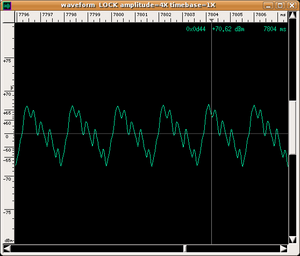
|
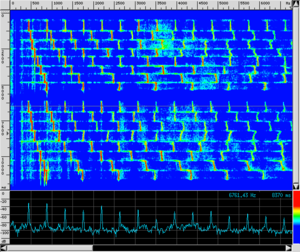
|
|
The position of the bow
Along with the force applied by the bow (determined by the weight of the musician's arm counterbalanced by their muscular action), the violinist can also vary other parameters. One of the most important is certainly the position of the point of contact between the bow and string. The bow can be drawn particularly close to the fingerboard or bridge, while normal sound is obtained in an intermediary position. In the example, we will first hear a sound played with the bow in the standard position, then sul tasto (on the fingerboard), and finally sul ponticello (on the bridge). The sound "on the fingerboard" favours the first mode taking energy away from the upper harmonics and produces a more delicate timbre. The sound "on the bridge" is sharper and completely suppresses the fundamental mode of the string in favour of the higher modes. In the example, we can soon hear the first harmonic one octave above the fundamental emerge and in the sonogram we can see a graphic confirmation of this perception.
| Wave form |
Sonogram |
Audio |
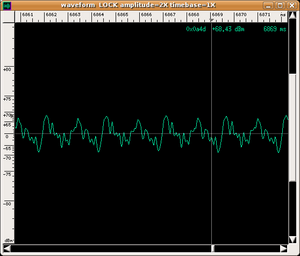
|
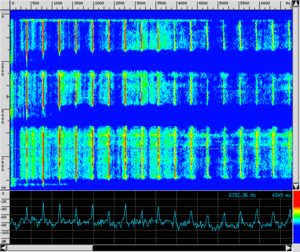
|
|
The "vibrato"
The "vibrato" sound is obtained on the violin by lightly moving the finger of the left hand back and forth stopping the string. It is a small frequency modulation of the sound base; the frequency, amplitude and time envelope of which are entirely chosen by the violinist depending on how they wish to express themselves musically. The "vibrato" "warms" the sound by amplifying the harmonics involved and modifying the spectral content over time. It can be used to create a very wide range of expressions. In this case, we can see a amplitude modulation in the plot of the wave form up to about ±4 dBm at a frequency of 7 Hz, which is associated with a simultaneous frequency modulation of about ± 15 Hz.
| Wave form |
Spectrogram |
Audio |
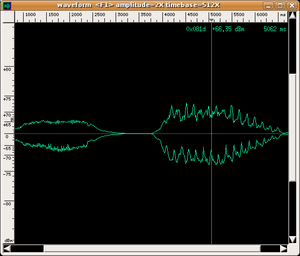
|
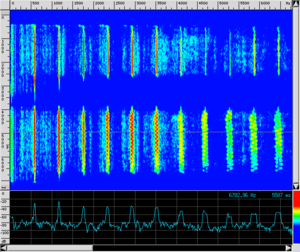
|
|
The sound attack
In the formation of timbre, along with the stationary spectrum, the time envelope of the spectrum and the envelope of the total intensity are also very important. In the sample, we can hear a soft attack and a sforzando attack. In this case, the time of the soft attack is about one second, while the sforzando attack lasts approximately 0.09 of a second.
| Wave form |
Spectrogram |
Audio |
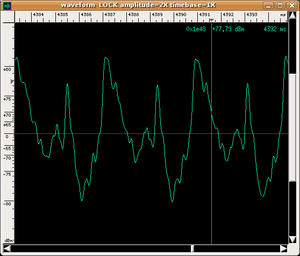
|
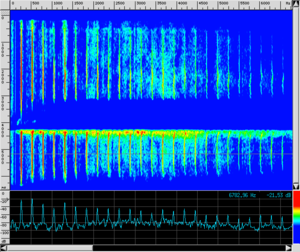
|
|
Sound intensity
In the sample, we can hear a violin playing a C♯3 first piano and then forte. In both cases, the harmonics reach up to the audible threshold and get weaker at higher frequencies. However, in the "piano" example, they are damped more quickly than in the "forte" example, which we can clearly see in the normalised spectra (i.e. in which the intensity of the fundamental was scaled to be the same). In the "forte" sample, the "tremolo" of the higher harmonics is visible at the sound attack. The difference in the total power (or "dynamic range") between the two cases is about 7 dBm. It is interesting to note that the presence of many violins in an orchestra highly increases the dynamic range. This does not only mean that a louder "fortissimo" can be obtained but that the "pianissimo" also improves. The presence of many instruments averages out both small imperfections and the natural rustle of the sound of the piano allowing the orchestra to achieve a richer sound when the total intensity is minimum.
| Wave shapes |
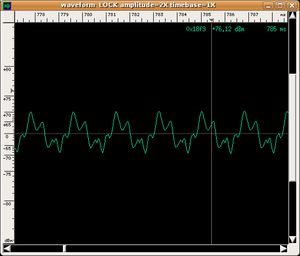
|
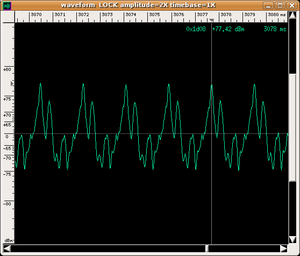
|
| Sonogram |
Normalised spectra |

|
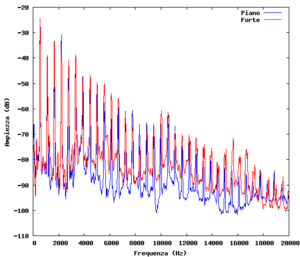
|
| Audio |
|
|
Open strings and fingering
As we have previously mentioned, the main function of the left-hand fingers is to modify the length of the portion of vibrating strings allowing for the production of notes that are different than those played on free strings (musicians call them open strings). However, we must observe that the fingers also have an expressive function that goes beyond the fine tuning of intonation and "vibrato". In particular, the same note can be executed in various modes by shortening different strings. We say that notes can be produced with different "fingerings". In the complex sequence of notes that make up a piece of music, the choice of one type of fingering over another can be of great importance to both simplify the execution and obtain a particular timbre or sound quality.
| Wave form |
Spectrogram |
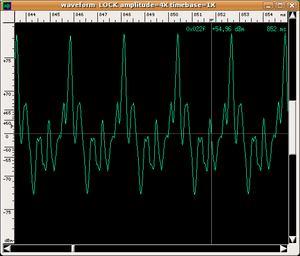
|
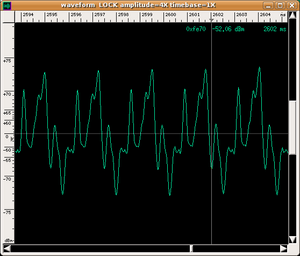
|
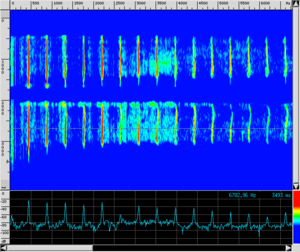
|
| Comment |
Audio |
| Here is a simple example; listen to a single note that that is first executed on the open second string and then fingered on the third string with a much shorter length. Note that the open string has a much more metallic and shrill timbre. |
|
| Wave form |
Spectrogram |
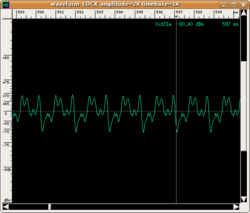
|

|

|
| Comment |
Audio |
| Here is another example of the same type but with two different fingerings (i.e. without using open strings): the D4 is executed firstly on the second string and has a much lighter timbre than the second, which is executed on a lower string of the instrument. However, as the spectrogram confirms, both have the same fundamental frequency and the same harmonics, albeit distributed with different amplitudes. |
|
The mute
The mute of the violin is a device mounted on top of the bridge. Its function is to add mass to the bridge, which greatly increases inertia and, therefore, partially impairing its function as a vibration transmitter. Briefly, the mute damps the intensity of the sound produced by the instrument, however, it also drastically modifies the timbre making it more "intimate". In the sample, the same note is played more or less with the same strength and with various types of mutes with increasing masses.
| Various mutes |
Spectrogram |
Audio |
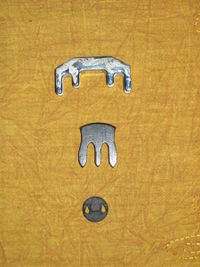
|
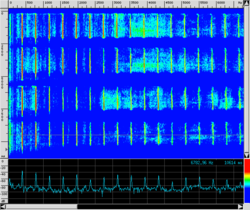
|
|
| Wave shapes |
| Mute 1 |
Mute 2 |
Mute 3 |

|
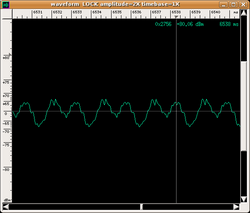
|
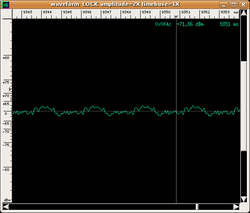
|
Directionality
- At low frequencies (200-500 Hz), sound is radiated from the violin in a direction perpendicular to the belly and back. The somewhat figure-eight shape of the radiation diagram resembles that of a dipole, which suggests that the belly and back oscillate in phase at low frequencies. This is due to the fact that the sound post couples the belly and back very efficiently at low frequencies.
- At medium frequencies (500-2000 Hz), the radiation diagram shows various lobes, which indicate that the belly and back are oscillating with a reciprocal phase delay and that various points on the surface of the top and bottom no longer oscillate in phase.
- At high frequencies (above 2000 Hz), most of the radiation comes from the belly indicating that the sound post is no longer an efficient coupling with the back.
Musical particularities
The violin is perhaps the one instrument of them all that offers a wide range of articulations, timbre nuances and dynamic range covering a wide range of notes. It is not by chance that it is the "prince" of the symphonic orchestra, the one indispensable element of any chamber or folk ensembles and the preferred instrument (along with the piano) for which solo pieces are composed.
To exemplify this, we will analyse the Chaconne in D minor for Solo Violin by J. S. Bach, which in fact is a path of "exploration of the instrument" and exaltation of all its potentiality.
Chaconne in D minor by J. S. Bach
The first characteristic that is evident is the length of the piece: about a quarter of an hour of music for solo violin, which would be unthinkable to maintain (from both a formal and perceptual point of view) without a wise and progressive discovery of all the technical and expressive aspects that distinguish the instrument. Such a deep and rich "exploration" has expressive implications of unprecedented geniality, in particular in the idea of a type of "explosion" of the violin in a sort of orchestra of violins, for which, throughout the composition, we constantly have a feeling of a latent polyphony based on the ambiguity of the perception of one, two, three, four and more independent voices.
Compositional analysis: first part
|
The chaconne is a form based on the enunciation of a thematic cell and the cyclical repetition of its low harmonic. From the presentation of the theme, the composer's intentions are clear: we are facing a sequence of chords (three voices), during which traditional monadic composing for the violin is negated (or better, outclassed). The violinist plays two or three strings simultaneously (often playing fast arpeggios to guarantee simultaneous perception), exploiting the characteristic timbre of open strings (i.e. played without fingers touching the strings to stop the resonance or produce a "vibrato") in the first three harmonies.
|
|

|
|
In the first variation, a solo voice is interrupted by small chord intermissions (which create continuity with the preceding episode): this is a type of "responsorial" event that contrasts a solo voice with a virtual "all".
|
|

|
|
In the second variation, a second voice with a chromatic character clearly appears, while the third variation, given the asymmetry in the dislocation of the bichords, offers the first sign of that ambiguity in the recognition of the voices that we previously mentioned: the line is theoretically monadic, yet it is impossible to ignore the fleeting appearance and disappearance of parallel voices.
|
|

|
|
|

|
|
That "suspicion" is confirmed in the fourth variation, where the chromatic element reappears but this time is quite clearly distributed on two registers (which correspond to two violin strings). While the perception of the two voices (Bach's famous "virtual polyphony") is very easy in this episode, it is more difficult in the following variation, where it seems as if the violin happily ambulates sometimes moving, sometimes resting, sometimes intersecting the various previously defined registers. This artifice is made possible thanks to the ease with which the violinist can very quickly move from string to string spanning wide intervals (this is a particular aspect of all bowed instruments).
|
|
|

|
|
The game continues increasing the velocity and technical difficulty (also to exalt the musician's virtuosity) until it returns to the initial theme, which closes the first part of the chaconne.
|
|

|
Compositional analysis: second part
|
The second part is in D major, however, Bach persists with his initial intentions: after a calm presentation of the theme, a very important episode begins (above all for the consequences it will have in the third part), characterised once again by the idea of an '"explosion" of the instrument. In the first stage, we can hear a descending gesture (that insists on a high A only in the first two arpeggios). Then, in the second stage, that same A is repeated three times creating a sort of pedal (and here rises the doubt of the presence of a second voice).
|
|

|
|
|

|
|
There follows a third stage, where the repetition of an A in a lower octave and is played on two strings (remember that the A is one of the open strings of the violin!). Finally, there is a fourth stage of development, where the A is projected one octave lower again and, this time, the "two instruments" clearly emerge.
|
|
|

|
|
|

|
Compositional analysis: third part
|
Jumping to the end of the third and last part (in D minor again), we can hear the supreme exegesis of this A that Bach has carved into our memory in the second part. Here, we reach the highest level of thematic ambiguity: we perceive one voice, then we realise that there are two, then three, and, in the end, perhaps there are even four. Once again, the technical and articulation potentialities of the violin are exploited to their maximum: the open strings, the possibility of playing on several strings simultaneously, the versatility of changing from high to low registers, the variety of timbres from the soft and diaphanous attack "at the tip" to the rude and aggressive attack "at the frog" (i.e. the two end points of the bow).
|
|
|

|
|
The final tension converges again in the last and final apparition of the base theme, the supreme synthesis of the research about the instrument that has been carried out. At this point, it would be worthwhile to listen to the entire composition.
|
|

|
Observations and links
There are other members of the string instrument family for which the production of sound is similar to that of the violin. While these instruments (from high to low, the violin, viola, cello and contrabass; see the page on Range of string instruments) have the same acoustic mechanisms of sound production, they are distinguished by their size and tuning.
Anharmonic effects of strings
Real strings differ from ideal ones and, therefore, the simplified vision of the eigenfrequencies of strings that can generate a series of perfectly harmonic resonances (i.e. integer multiples of the fundamental frequency) can be applied to real instruments only in the first approximation.
In particular, real strings can deviate from ideal conditions for various reasons:
- finite diameter: even though it is very small, the finite diameter of a string can influence resonance frequencies
- presence of internal frictions: tension is never perfectly homogeneous along a string
- presence of frictions: the constraints at the ends (such as the nut and bridge) are not perfectly fixed (even if their movements are generally negligible with respect to the maximum amplitude of the oscillations of the string)
- existence of internal sheer forces: particularly at high frequencies, it is not possible to consider a string as perfectly flexible because consecutive sections that move in phase oppositions can also exert transversal forces along with tension. This can be seen when trying "tightly tie" a string: the smaller the wires, the more difficult it will be. This results in an effective dispersion of the medium, which causes the upper harmonics to have a higher frequency than the ideal harmonic ratio. However, this effect is much more evident in plucked or struck string instruments rather than in bowed string instruments because bowing distributes less energy to the very high harmonics with respect to striking or plucking.
In-depth study and links
- We suggest you read the fundamental page on Sound and resonance, in which you will find a description of the general principles of the functioning of musical instruments. This reading will help you to better appreciate the particulars of the instrument described on this page.
